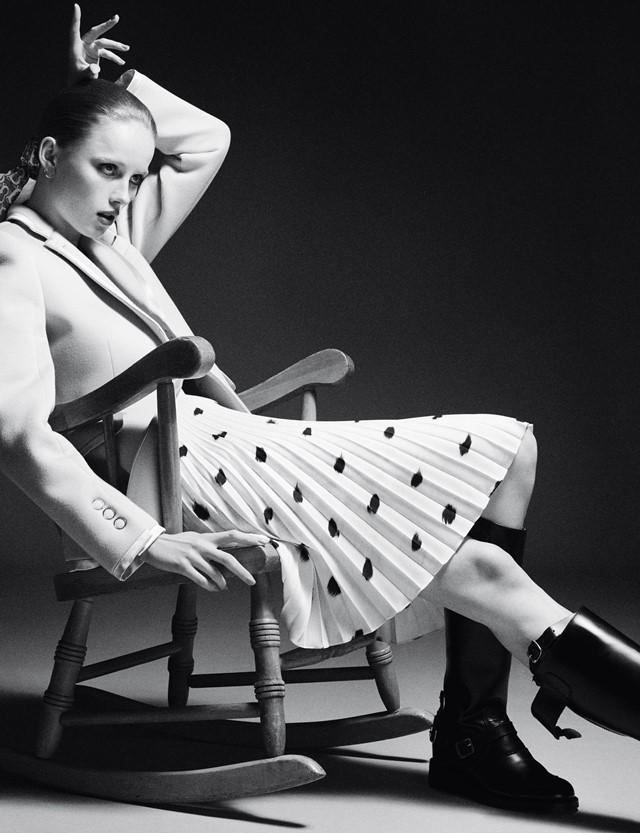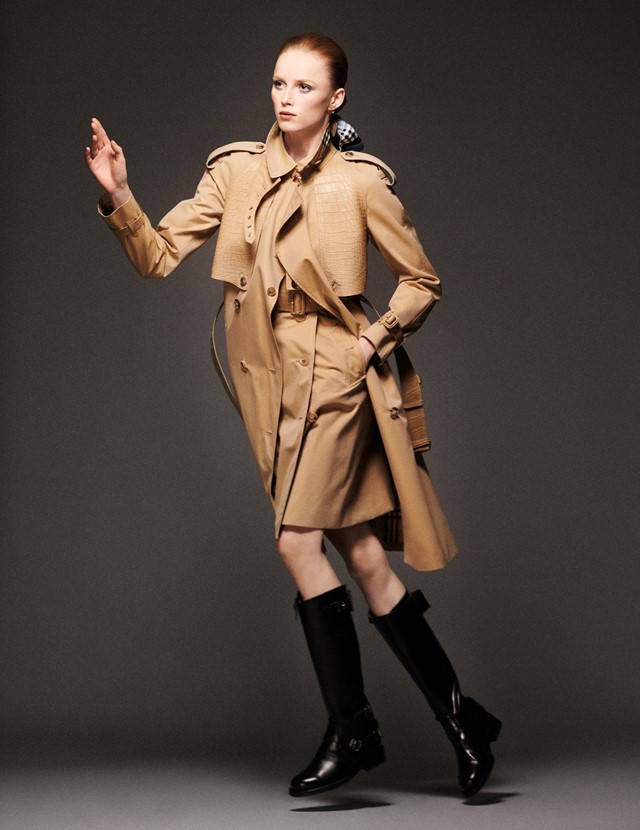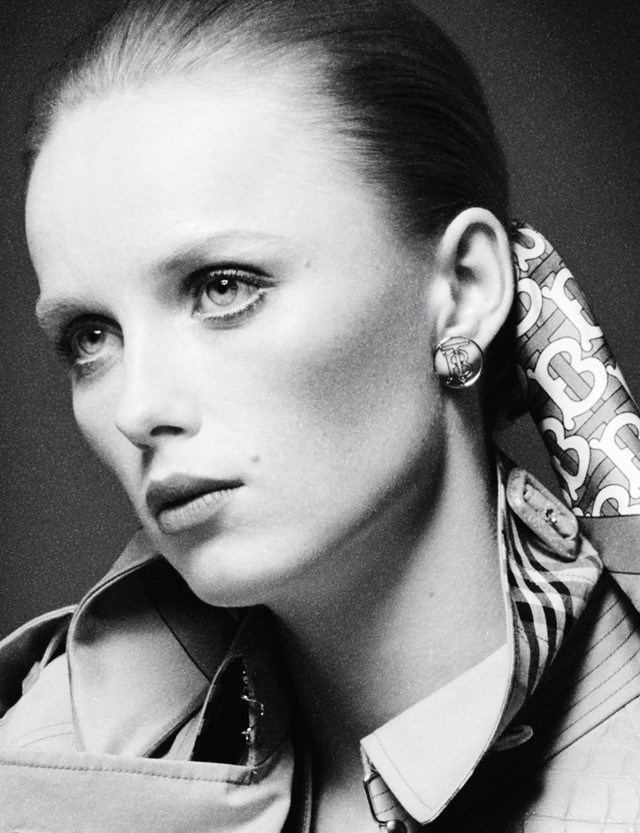From his unswerving love of Britain to that of his family, here are ten definitive facts from AnOther Magazine’s new cover story with Burberry’s new emperor
1. While Tisci’s schoolmates wore Emporio Armani, Tisci went to school in his sisters’ hand-me-downs. Often, they were pink. “Funny, though, because I never really suffered. My home was heaven. My mother was incredible. She never made us feel different, and I used to come home from school, play with my sisters, watch them getting dressed to go out. I was safe at home… happy.”
2. It was the UK and its welfare system that gave Tisci the start to his career – for which he remains eternally grateful. “You know, income support, my apartment paid for. This country gave me the opportunity, even though my English was bad.” He still took on casual work – as a doorman at former high-street chain Mark One and as a shop assistant at Monsoon – and worked in the London studio of fellow Italian Antonio Berardi. When reminded that such assistance would not be offered to a fledgling designer of his background, however talented, now: “That’s true. Oh God, you’re giving me goosebumps – it wouldn’t happen now,” he says. “But still, it’s thanks to England that I am who I am. I never dreamt I could come here to study. The British love of freedom of expression brought me here. And I never for one second thought I would become what I have become today.”
3. The designer is a huge fan of Vivienne Westwood – her work shaped his attitudes to gender. So much so that one of the first things he did at Burberry was to invite her to create a capsule collection for the brand. “Vivienne is like a god to me,” he says, “and to many people. She represents so much to so many people. When I first saw her work I was this young, gay boy in Italy looking at magazines. Femininity in a man is no problem, she taught me that.” The elder designer was, he says, marginally thrown when he first approached her for the collaboration. “She said, ‘You are like the king of England now, why do you want to celebrate me?’ I answered, ‘I’m only here because of you, you were the one who opened my eyes.’”
4. Inspiration for his first Burberry collection came from Britain’s tourist trappings. “It was like collecting different things that represent England,” he explains. “I sent my team out into the street and asked them to take pictures of things, pictures of typically English things. It was nice. Then we made a list – the history of England, the evolution of the Victorian times, the street tribes. So it was all these strong images of England, pulled together to make an homage. Then we thought of typical words, like, sorry for the vulgarity, but one of the first phrases that I learnt when I came here was ‘fucking cow’.” Tisci smiles, wide. “That is really English. So is the word God – ‘Oh, God!’” These elements, forensically collated, found their way onto clothing. Portraits of Victorian ladies and gentlemen were printed across silks and tailored trousers, fishnet veiled a polo shirt, the words SOCIETY and WONDERFUL were stamped on scarves. WHY DID THEY KILL BAMBI? was a direct nod to the Sex Pistols, I WEEP FOR JOY TO STAND UPON MY KINGDOM ONCE AGAIN, to Shakespeare’s Richard II.
5. His family is paramount – he left Givenchy simply to spend time with them. “I took my sabbatical because, when I came to London when I was 17, I completely changed my life and the lives of another nine people, my mum and my sisters,” Tisci says. “I come from a very poor family. Everything went so fast and they were so proud of me, but the year before I left Givenchy, my sister’s husband died. I was at work in Paris, it was just before the haute couture, I took the flight to Como, I arrived at the funeral and saw everybody. I was late. I arrived the moment the body came into the church. I sat down and just looked around me. I saw my mum next to me looking frail, small, the kids growing, all my friends and everybody in the family, and I was just like, ‘No, that’s that.’ I went back to Paris and told them that I didn’t want to work any more, that I wanted to stay with my family. And I’m so glad,” Tisci continues. “I think I gave my mum another ten years. Touch wood. Because I spent one year with her, doing normal things. Before that, I made my family happy financially, tried to go to Italy every Christmas and birthday, but to spend a real healthy 20 days together was not something I had done for a long time. So that was amazing.”

6. The Riccardo Tisci label was born at his home – having moved back to Milan, Tisci worked for Puma, Coccapani and then the pioneering leather-goods brand Ruffo Research, but just as he was completing his first collection for that company, in the summer of 2004, it closed. And so the Riccardo Tisci label, darkly romantic, delicately gothic, was born, made by the designer at home, with the help of his mothers and sisters, and shown off-schedule. Orders began coming in...
7. Björk was his first famous client – her support came along with those first orders and Tisci’s collection was first featured in French and British Vogue and in Dazed & Confused at a time when very little press were paying attention.
8. Tisci was announced as the creative director of Givenchy less than a week after his second show – shown in a disused factory in the suburbs and based on the Lenten parades of Catholicism, it was a breakthrough. Presented against a backdrop of a monolithic crucifix and modelled by Mariacarla Boscono – a dear friend whose face also appeared on the illustration for Tisci’s graduate collection invitation – and her contemporaries for free, it caused a sensation. The day after, Tisci says, aged just 30, he received a call from Marco Gobbetti, CEO of Givenchy, followed by Céline, and now Burberry, neatly enough. “Marco is the person who, when I was a little kid from Milan, brought me to Paris and gave me the chance. He gave me Givenchy, he was the one who fought with everybody to get me there. He’s like a father to me.”

9. Tisci embraced otherness from the start, at Givenchy casting his childhood friend Lea T both on the runway and for a Givenchy A/W10 print advertising campaign. He commissioned Antony Hegarty – now Anohni – to create a live soundtrack for his blockbuster A/W13 womenswear show. “Transgender for me has always been something normal,” Tisci says. “Lea used to be my assistant. Sometimes she used to go to the cemetery with my mum. She was a transexual, taking my mum to the cemetery in a little village. People said nothing. Italian people may criticise but they never judge in a strong way. What I did – and I’m not saying it is good or bad or right or wrong – is maybe what society was missing at that time. That’s done now. That was my story, that was the past.”
10. Tisci’s father died when he was so young he cannot remember him – his father’s ghost has always been behind him as he told Susannah Frankel at the beginning of his career. Now he says: “I worked on that for a while. I wish there was another world where you could meet the people you didn’t have a chance to meet here. I wish I could meet my father just for one day, this man who everybody describes. The love that I was supposed to give to this man I gave to my mum and to my sisters. But he is not the ghost that sits behind me any more. He sits next to me now. I’ve grown up. When I saw my mum at Christmas, I was so glad. I don’t know what’s going to happen tomorrow, and that is very hard, but in the end that is the beauty and the reality of life.”
Hair: Gary Gill at Streeters. Make-up: Niamh Quinn at LGA Management using MAC. Model: Rianne Van Rompaey at Viva London. Casting: Noah Shelley at Streeters. Set design: Alice Kirkpatrick at Streeters. Digital tech: Simon Wellington. Photographic assistants: Peter Carter and Albi Gualtieri. Styling assistants: Laura Vartiainen and Hugo Lavin. Hair assistant: Tom Wright. Make-up assistant: Izzy Kennedy. Producers: Ciara Smith and Claire Green at Rep. Post-production: Hempstead May
Taken from an interview with Susannah Frankel, originally featured in the Spring/Summer 2019 issue of AnOther Magazine which will be on sale internationally from February 14, 2019.






